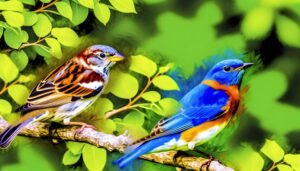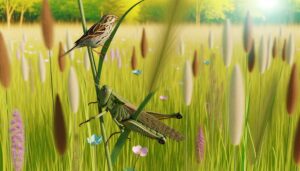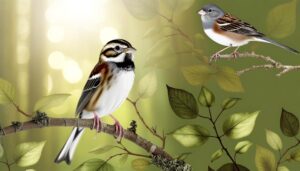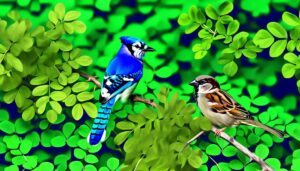House Finch Vs Sparrow – 3 Key Identification Tips
House Finches (Haemorhous mexicanus) exhibit sexual dimorphism; males have red plumage on their heads and throats, while females are brown-streaked. In contrast, House Sparrows (Passer domesticus) showcase uniform coloration with gray heads and black bibs.
House Finches produce complex warbling songs, whereas House Sparrows emit repetitive chirps. Their diets also differ: House Finches consume seeds and fruits, while House Sparrows have an opportunistic diet.
Nesting habits vary, with House Finches building cup-shaped nests in trees and Sparrows favoring dome-shaped nests in cavities. Habitat preferences further distinguish them, reflecting unique evolutionary adaptations.
There's much more to discover about these intriguing birds.
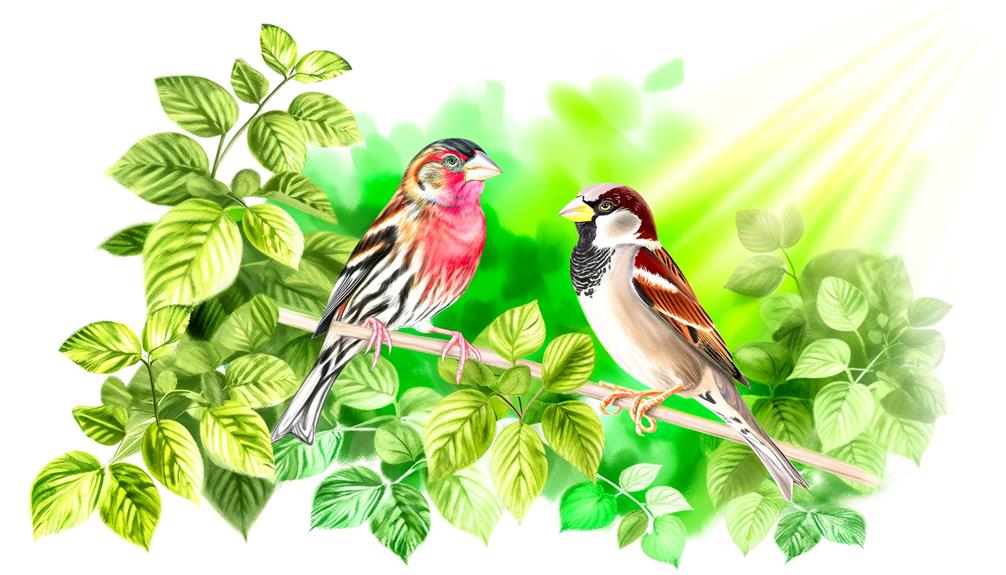
Key Takeaways
- House Finch males have vibrant red plumage, while House Sparrow males have gray heads and black bibs.
- House Finches produce complex warbling notes; House Sparrows emit simple, repetitive chirps.
- House Finches primarily eat seeds and fruits; House Sparrows have a more varied diet, including human food scraps.
- House Finches build cup-shaped nests; House Sparrows construct dome-shaped nests with side entrances.
- House Finches prefer semi-arid regions and urban areas; House Sparrows are ubiquitous in urban and agricultural environments.
Physical Appearance
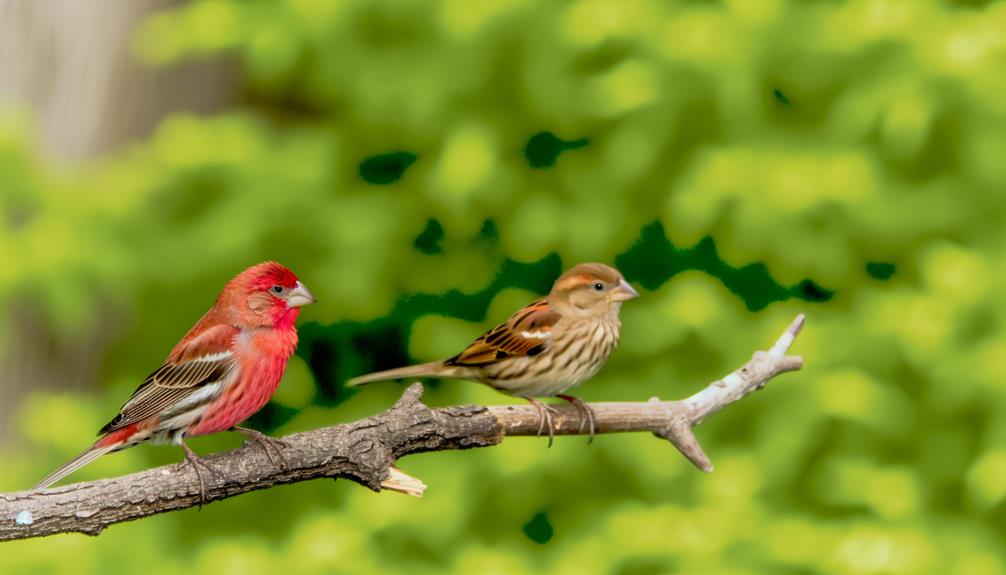
When comparing the physical appearance of the House Finch (Haemorhous mexicanus) and the Sparrow, notable differences can be observed in their plumage coloration and body structure.
The House Finch males exhibit vibrant red plumage on their heads, throats, and chests, contrasting with their brown-streaked flanks and backs. Females display more subdued brown tones with streaked underparts, aiding in camouflage.
In contrast, the Sparrow, specifically the House Sparrow (Passer domesticus), presents a more uniform coloration. Males possess gray heads, white cheeks, and black bibs, while females and juveniles are mostly brown with streaked backs.
Additionally, House Finches have a more slender body and a longer, curved beak, optimizing their feeding on seeds and fruits, unlike the Sparrow's robust, conical bill.
Vocalizations
Regarding vocalizations, House Finches (Haemorhous mexicanus) produce a series of warbling notes that vary in pitch and are often described as cheerful and melodic, whereas House Sparrows (Passer domesticus) emit repetitive and monotonous chirps. House Finch songs display a complex sequence of tweets and trills, reflecting their dynamic vocal range. In contrast, House Sparrows rely on simple, sharp "cheep" sounds to communicate, often signaling territory or alerting to predators.
| Species | Vocalization Characteristics |
|---|---|
| House Finch | Warbling notes, varied pitch |
| House Sparrow | Repetitive, monotonous chirps |
| House Finch | Cheerful and melodic |
| House Sparrow | Simple, sharp "cheep" sounds |
Their vocal differences highlight unique communication strategies, with the House Finch's varied songs contrasting with the House Sparrow's straightforward calls.
Feeding Habits

Shifting from their distinct vocalizations, House Finches (Haemorhous mexicanus) primarily consume seeds, fruits, and buds, showing a preference for sunflower seeds, while House Sparrows (Passer domesticus) exhibit a more opportunistic diet, feeding on grains, insects, and human food scraps.
House Finches employ a specialized bill morphology to efficiently dehusk seeds, optimizing their consumption of high-energy food sources, particularly during breeding seasons.
Conversely, House Sparrows demonstrate ecological plasticity, exploiting varied food resources in urban settings. They forage on the ground and in trees, adapting their diet to seasonal availability.
Both species contribute to seed dispersal but exhibit distinct foraging strategies—House Finches favoring consistency, while House Sparrows thrive on adaptability, ensuring their survival in diverse environments.
Nesting Behavior
House Finches (Haemorhous mexicanus) construct cup-shaped nests typically in trees, shrubs, or building ledges, utilizing twigs, grasses, and feathers to provide structural integrity and insulation for their eggs. The female primarily oversees nest-building, completing it within a week. Importantly, House Finches will reuse old nests, modifying them as needed.
In contrast, House Sparrows (Passer domesticus) build more enclosed, dome-shaped nests with side entrances, often found in cavities or crevices. They incorporate a variety of materials, including paper and string, to create a multi-layered structure. House Sparrows exhibit a more aggressive nesting behavior, often displacing other bird species.
These differences in nesting strategies reflect their unique evolutionary adaptations and ecological niches, fostering species-specific reproductive success.
Habitat Preferences
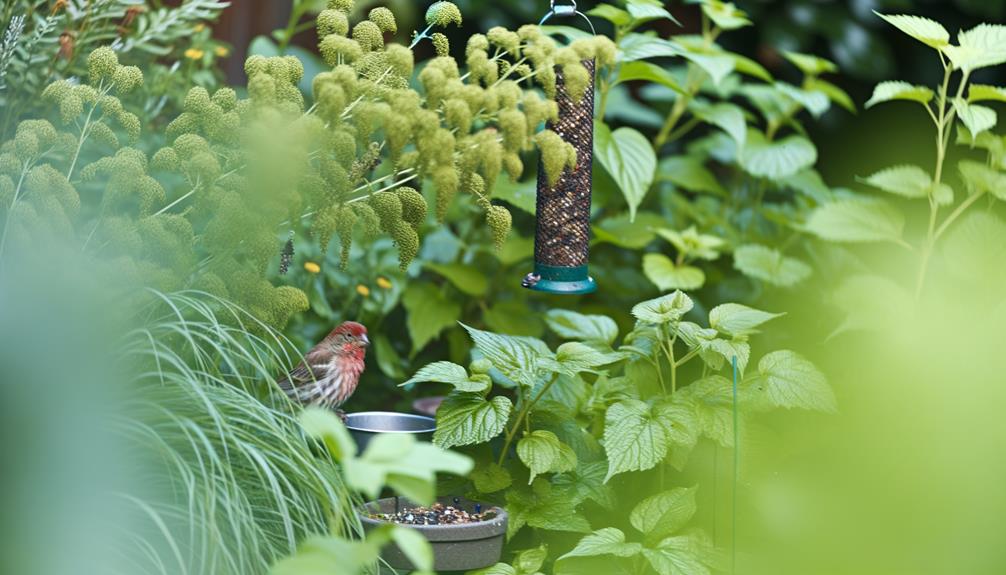
Both Haemorhous mexicanus and Passer domesticus display distinct habitat preferences that are closely tied to their foraging and nesting requirements. House Finches (Haemorhous mexicanus) favor urban and suburban environments where they exploit feeders and ornamental plantings. They also thrive in semi-arid regions, utilizing shrubs and low trees for nesting.
In contrast, House Sparrows (Passer domesticus) are ubiquitous in urban landscapes, often nesting in crevices of man-made structures. They exploit agricultural areas, scavenging grains and seeds. While both species are highly adaptable, House Finches prefer open spaces with scattered vegetation, whereas House Sparrows gravitate towards densely populated human habitats.
Their habitat choices reflect their evolutionary adaptations and resource availability, underscoring the intricate balance between species and environment.
Conclusion
In the grand tapestry of avian life, the house finch and sparrow are distinct threads woven with unique patterns. Their physical traits, vocalizations, feeding habits, nesting behaviors, and habitat preferences collectively paint a vivid dichotomy in ornithological studies.
The house finch, with its vibrant plumage (Haemorhous mexicanus), symbolizes creativity, while the humble sparrow (Passer domesticus) represents resilience. Observing these species reveals the intricate balance of nature, showcasing biodiversity's delicate yet robust interplay.

